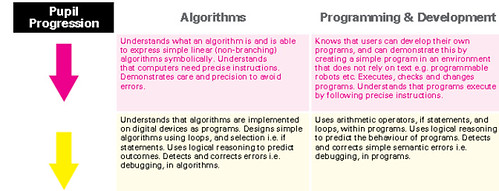UPDATED!
Since Michael Gove, England’s then Education Secretary, announced that Levels were not fit for purpose – the purpose being to assess and describe students’ proficiency in National Curriculum subjects – there has been a proliferation of attempts to assess Computing without using Levels. Many of these have taken the approach, quite naturally, of devising a progression grid of some sort. All the ones I’ve seen break the grid down into the Computing Programme of Study’s component parts, viz Computer Science, Digital Literacy, Information Technology and e-Safety. Some, like the Progression Pathways document created by Mark Dorling, go even further. In the case of the Progression Pathways, for example, the categories in the grid are:
- Algorithms
- Programming & Development
- Data & Data Representation
- Hardware & Processing
- Communication & Networks
- Information Technology

The comprehensive Progression Pathways approach to assessing ComputingThis approach has benefits, of course, not least the fact that it is fairly comprehensive (although I think more could have been made of e-safety: it’s there, but perhaps more explicit references would not have come amiss). I don’t wish to understate this: at a time when there was pretty much nothing, Mark created a document that covers the whole of the Computing curriculum, and in such a way that it would enable even the most programming-phobic teacher to at least get past the starting block. (You can find the most recent version in the resources section of the Computing at School website website, along with a document about digital badges. You will need to join Computing at School to gain access.)
Nevertheless, one issue with grids like this is what I call the “equivalence problem”. It’s subtle, but it’s important. In a nutshell, whether or not the items on the same row in the grid are meant to be taken as being on the same “Level”, that’s how they will be interpreted by most people. So the issue is this: are we to infer that items on the same row/Level are equivalent from a “capability/skills/knowledge/understanding” – whichever term you prefer – point of view? If so, is there some underlying intellectual framework upon which this equivalence is based? If it isn’t, the grid gives a misleading impression. It would be better, in that case, to have separate grids for each of the elements, ie separate documents, each of which is independent of the others.
Why is this important? Well, in a pragmatic sense, it probably isn’t. However, I’m interested in not just whether someone understands or can do particular things, but is able to think like a computer scientist. In those terms, I think thewhole is greater than the sum of its parts. A computer scientist will approach issues in a particular way. In fact, he or she will see the world in a different way. See, for example, Anna Shipman’s approach to building repairs in the article Applying computational thinking in the “real world”.
So for me, it is important to know if the items on each row are equivalent in some sense. That is because I want to be able to say something like, “Freda hasn’t completely grasped X, but as she ‘gets’ W, Y and Z, I think she thinks like a computer scientist. On the hand, although Joe understands X, Y and Z, he hasn’t grasped W, and therefore absolutely does not think like a computer scientist.” I don’t think you can do that unless you have an underlying framework of reference, and that you can say with near-certainty that items on a particular row of the grid are equivalent.
It seems to me that one way to avoid the issue or least get around it is to adopt the digital badges approach. There, you say that if a student has a particular bundle of skills, they earn a badge that reflects that fact. You don’t have to worry about whether one badge is equal to another, or even what the underlying framework is, or indeed if there even is one. All anyone is bothered about is the question, “Can the student demonstrate that they know or understand or can do this particular set of things?”
A good starting point for the badges approach are the Makewaves curriculum badges and the article about the Progression Pathways digital badges. See also Computing Curriculum Badges.
I think it’s a pity when people start creating bronze, silver and gold badges, but that’s a discussion for another day!
